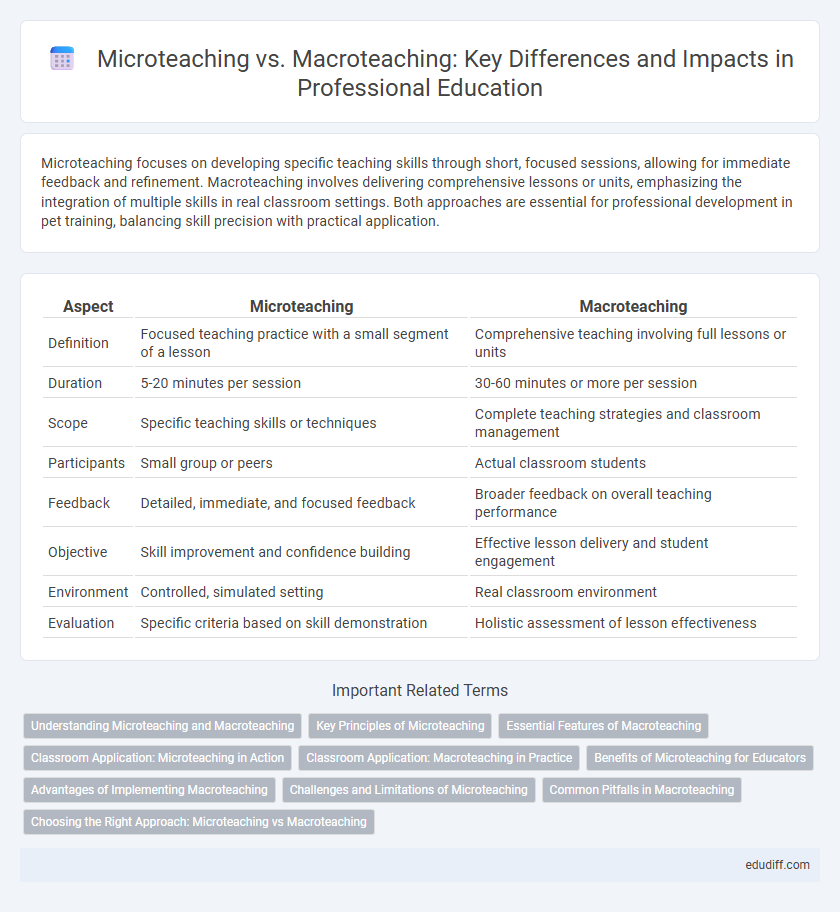Microteaching focuses on developing specific teaching skills through short, focused sessions, allowing for immediate feedback and refinement. Macroteaching involves delivering comprehensive lessons or units, emphasizing the integration of multiple skills in real classroom settings. Both approaches are essential for professional development in pet training, balancing skill precision with practical application.
Table of Comparison
| Aspect | Microteaching | Macroteaching |
|---|---|---|
| Definition | Focused teaching practice with a small segment of a lesson | Comprehensive teaching involving full lessons or units |
| Duration | 5-20 minutes per session | 30-60 minutes or more per session |
| Scope | Specific teaching skills or techniques | Complete teaching strategies and classroom management |
| Participants | Small group or peers | Actual classroom students |
| Feedback | Detailed, immediate, and focused feedback | Broader feedback on overall teaching performance |
| Objective | Skill improvement and confidence building | Effective lesson delivery and student engagement |
| Environment | Controlled, simulated setting | Real classroom environment |
| Evaluation | Specific criteria based on skill demonstration | Holistic assessment of lesson effectiveness |
Understanding Microteaching and Macroteaching
Microteaching is a scaled-down teaching approach designed for skill development in a controlled environment, enabling educators to practice and refine specific teaching techniques through brief, focused sessions. Macroteaching involves delivering comprehensive lessons in real classroom settings, emphasizing the application of instructional strategies to manage longer teaching periods and diverse student needs. Understanding the distinct purposes of microteaching and macroteaching helps educators enhance both technical proficiency and classroom management skills effectively.
Key Principles of Microteaching
Microteaching emphasizes focused skill enhancement by isolating specific teaching techniques for targeted practice in a controlled environment. It relies on principles such as clear objective setting, deliberate practice with immediate feedback, and video recording for reflective self-assessment. This approach allows educators to refine individual competencies before applying comprehensive teaching strategies in macroteaching scenarios.
Essential Features of Macroteaching
Macroteaching emphasizes comprehensive lesson delivery involving extended time frames and real classroom environments to enhance pedagogical skills. It incorporates full instructional cycles, includes diverse student interactions, and provides opportunities for reflective practice and feedback. This method prioritizes holistic teaching competencies over segmented skill practice typical of microteaching.
Classroom Application: Microteaching in Action
Microteaching emphasizes focused skill development through short, controlled teaching sessions, allowing educators to refine specific techniques in a simulated classroom environment. This method enhances classroom application by enabling immediate feedback and targeted practice, leading to improved lesson delivery and student engagement. Unlike macroteaching, which involves managing entire class periods, microteaching isolates critical teaching behaviors to foster professional growth efficiently.
Classroom Application: Macroteaching in Practice
Macroteaching in practice involves conducting extended lessons, typically lasting 40 to 60 minutes, allowing in-depth exploration of complex topics and real-time classroom management. It provides opportunities for authentic interaction with diverse student behaviors, assessment of instructional strategies, and adaptive teaching in larger group settings. This method enhances practical skills in lesson planning, time management, and student engagement, essential for effective classroom application.
Benefits of Microteaching for Educators
Microteaching enhances educators' skills by enabling focused, manageable practice sessions that allow for targeted feedback and self-reflection, promoting rapid improvement. This method supports the development of specific teaching techniques in a low-stakes environment, fostering confidence and competence before full-class application. Educators benefit from iterative cycles of concise teaching episodes that refine instructional strategies and improve student engagement.
Advantages of Implementing Macroteaching
Macroteaching offers the advantage of providing a comprehensive learning experience by simulating real classroom settings, which enhances practical teaching skills and classroom management strategies. It facilitates in-depth lesson planning and allows for extended interaction with students, fostering better assessment and feedback mechanisms. This approach supports the development of holistic instructional competencies essential for effective teaching in diverse educational environments.
Challenges and Limitations of Microteaching
Microteaching faces challenges such as limited real-world complexity, which restricts the scope of classroom management and student interaction skills development. Its controlled environment often fails to simulate unexpected disruptions or diverse learner needs, limiting the preparedness for full-scale teaching contexts. Time constraints in microteaching sessions also inhibit the practice of comprehensive lesson planning and execution.
Common Pitfalls in Macroteaching
Common pitfalls in macroteaching include inadequate lesson planning, insufficient time management, and lack of adaptability to diverse student needs. Teachers often struggle with maintaining student engagement in larger class settings compared to microteaching sessions. Overemphasis on content delivery rather than interactive learning can reduce overall teaching effectiveness in macroteaching environments.
Choosing the Right Approach: Microteaching vs Macroteaching
Selecting between microteaching and macroteaching hinges on specific instructional goals and context; microteaching excels in refining targeted teaching skills through brief, focused sessions usually involving peer feedback, while macroteaching encompasses comprehensive lesson delivery in real classroom settings, fostering broader pedagogical competence. Microteaching is particularly beneficial for novice educators seeking to develop core competencies in controlled environments before engaging with actual students. Macroteaching suits experienced instructors aiming to practice full-scale lesson implementation and classroom management under authentic conditions.
Microteaching vs Macroteaching Infographic

 edudiff.com
edudiff.com